Intel Xeon Gold 6252 Benchmarks
For this exercise, we are using our legacy Linux-Bench scripts which help us see cross-platform “least common denominator” results we have been using for years as well as several results from our updated Linux-Bench2 scripts. Starting with our 2nd Generation Intel Xeon Scalable benchmarks, we are adding a number of our workload testing features to the mix as the next evolution of our platform.
At this point, our benchmarking sessions take days to run and we are generating well over a thousand data points. We are also running workloads for software companies that want to see how their software works on the latest hardware. As a result, this is a small sample of the data we are collecting and can share publicly. Our position is always that we are happy to provide some free data but we also have services to let companies run their own workloads in our lab, such as with our DemoEval service. What we do provide is an extremely controlled environment where we know every step is exactly the same and each run is done in a real-world data center, not a test bench.
We are going to show off a few results, and highlight a number of interesting data points in this article.
Python Linux 4.4.2 Kernel Compile Benchmark
This is one of the most requested benchmarks for STH over the past few years. The task was simple, we have a standard configuration file, the Linux 4.4.2 kernel from kernel.org, and make the standard auto-generated configuration utilizing every thread in the system. We are expressing results in terms of compiles per hour to make the results easier to read:
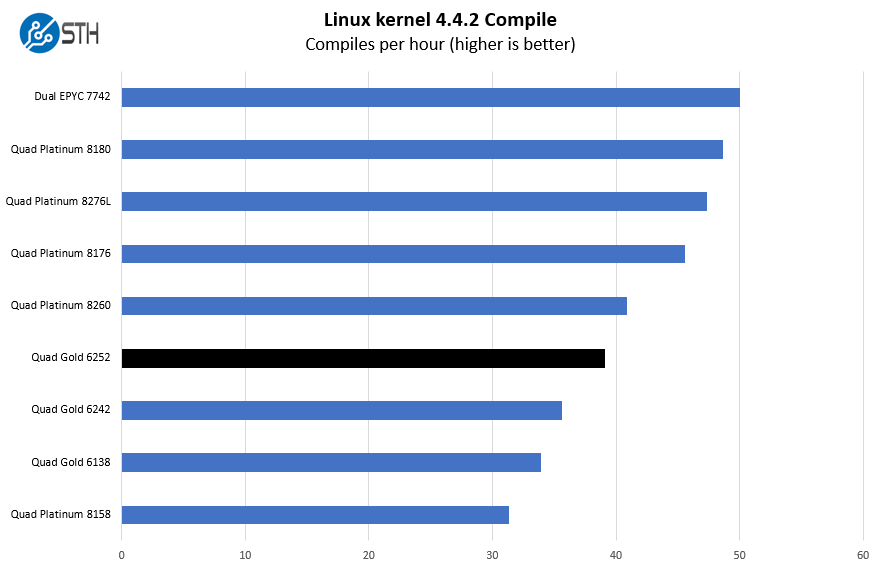
Here we can see 96 cores and 192 threads performing well. The configuration narrowly trails the quad Platinum 8260 configuration which makes sense given the slightly lower clock speeds on the Gold 6252.
c-ray 1.1 Performance
We have been using c-ray for our performance testing for years now. It is a ray tracing benchmark that is extremely popular to show differences in processors under multi-threaded workloads. We are going to use our 8K results which work well at this end of the performance spectrum.
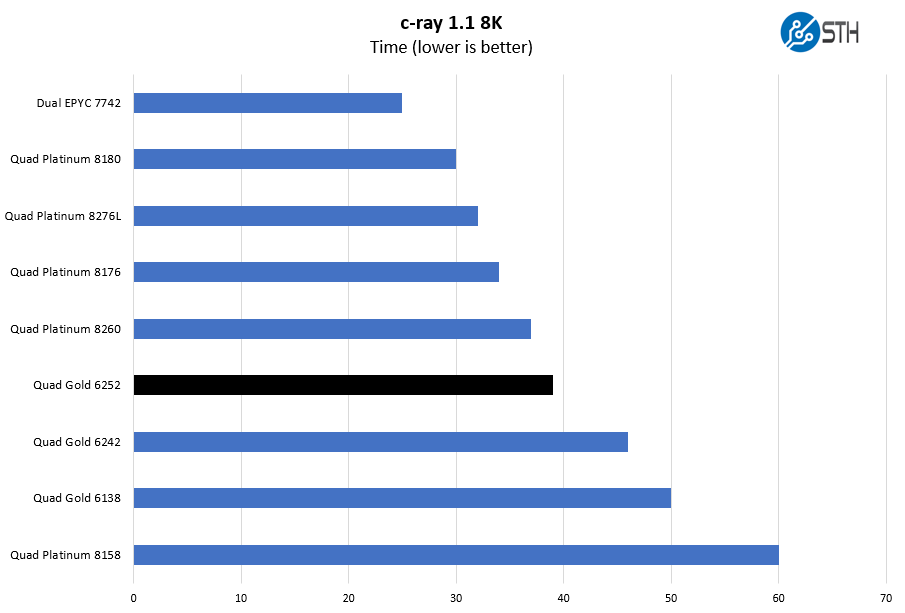
Here you are going to see the dual AMD EPYC 7742 system do well. This is typically a benchmark that showcases AMD’s architecture well. Although AMD’s system is only a dual-socket affair, AMD can now put 64 cores into each socket. Those EPYC 7742’s are about twice the price of a Xeon Gold 6252. AMD is benefiting from a more modern process and architecture at this point and that will show, albeit not as much as it is here.
7-zip Compression Performance
7-zip is a widely used compression/ decompression program that works cross-platform. We started using the program during our early days with Windows testing. It is now part of Linux-Bench.
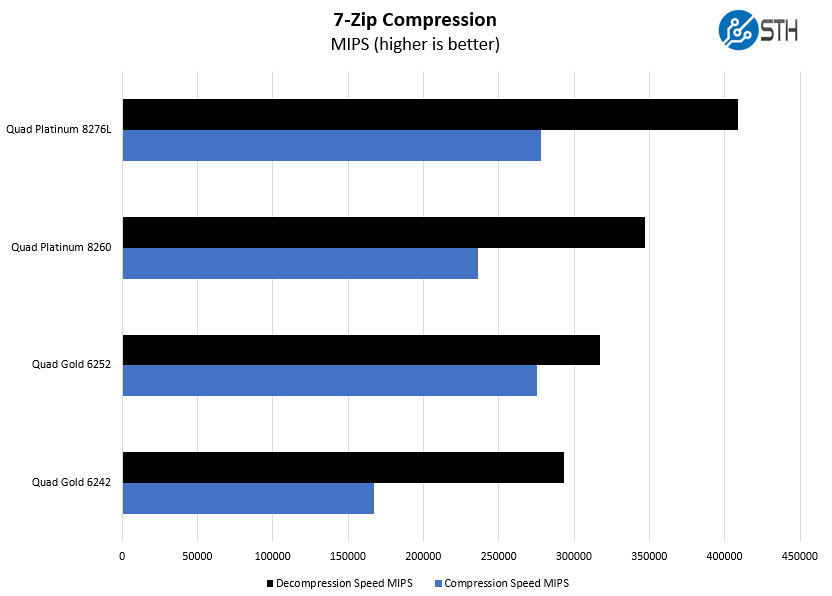
We wanted to focus on the four 4P Xeon Gold 62xx and Platinum 8xxx results we have so far for this generation. The Intel Xeon Gold 6242 only has 16 cores per socket but those cores run at higher clock speeds. With the same 150W TDP and given how modern CPUs manage clock speeds in thermal and power limits, the Gold 6242, a per-core performance-optimized part, can often compete with the Gold 6252. If you are deploying into a per-core licensing model, that part can actually make more sense.
NAMD Performance
NAMD is a molecular modeling benchmark developed by the Theoretical and Computational Biophysics Group in the Beckman Institute for Advanced Science and Technology at the University of Illinois at Urbana-Champaign. More information on the benchmark can be found here. With GROMACS we have been working hard to support AVX-512 and AVX2 supporting AMD Zen architecture. Here are the comparison results for the legacy data set:
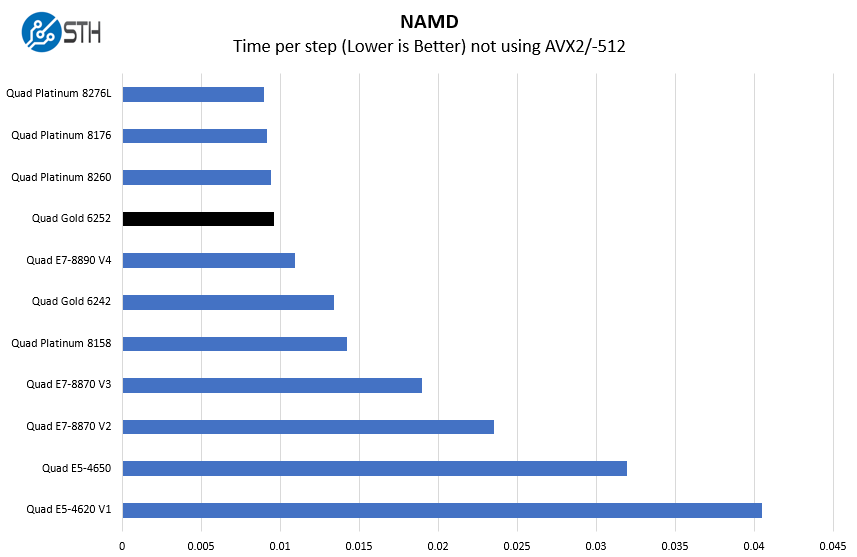
We have had this workload for some time. That allows us to show a view of how far we have come in the last nine years or so. If you are still running a Dell PowerEdge R930-era Xeon E7-8890 V4 system, you can get a very nice per-core performance bump even with legacy software not taking advantage of the latest extensions.
OpenSSL Performance
OpenSSL is widely used to secure communications between servers. This is an important protocol in many server stacks. We first look at our sign tests:
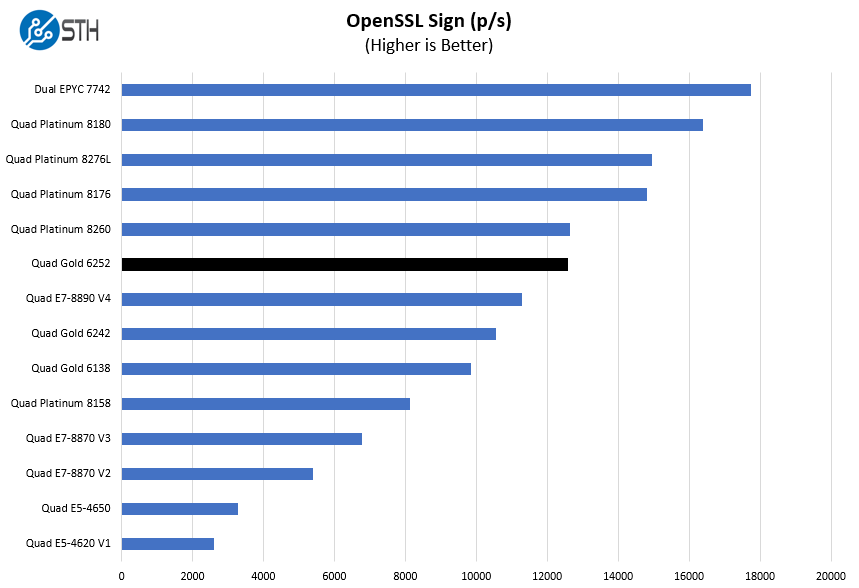
Here are the verify results:
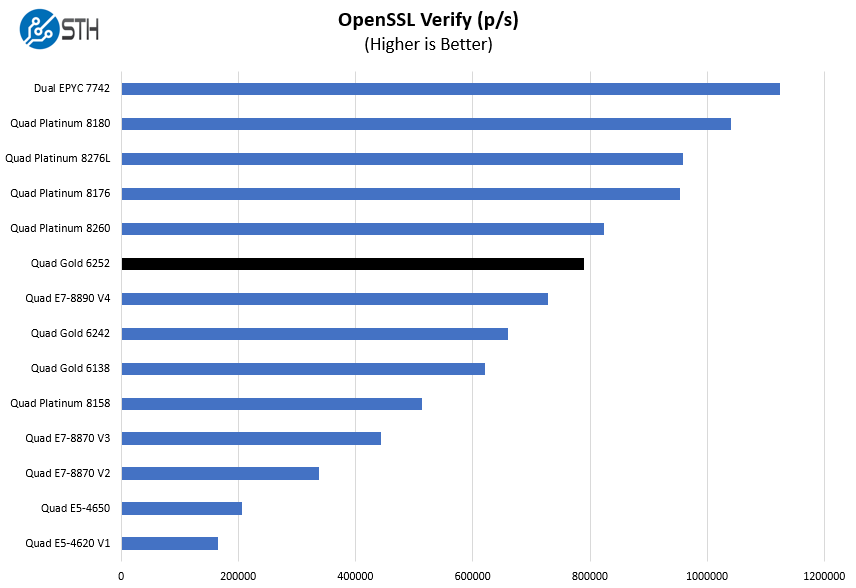
Here we see performance results about where we would expect with the 4P Xeon Gold 6252 configuration. The dual AMD EPYC 7742 system is still well ahead of this Gold 6252 configuration due to its architecture and core count benefits. We do not have four Intel Xeon Platinum 8280 CPUs, but one would expect them to perform slightly better than the quad Platinum 8180’s here. That means moving to 28 cores and 205W TDP leaves room to scale up in the sockets over the Gold 6252.
UnixBench Dhrystone 2 and Whetstone Benchmarks
Some of the longest-running tests at STH are the venerable UnixBench 5.1.3 Dhrystone 2 and Whetstone results. They are certainly aging, however, we constantly get requests for them, and many angry notes when we leave them out. UnixBench is widely used so we are including it in this data set. Here are the Dhrystone 2 results:
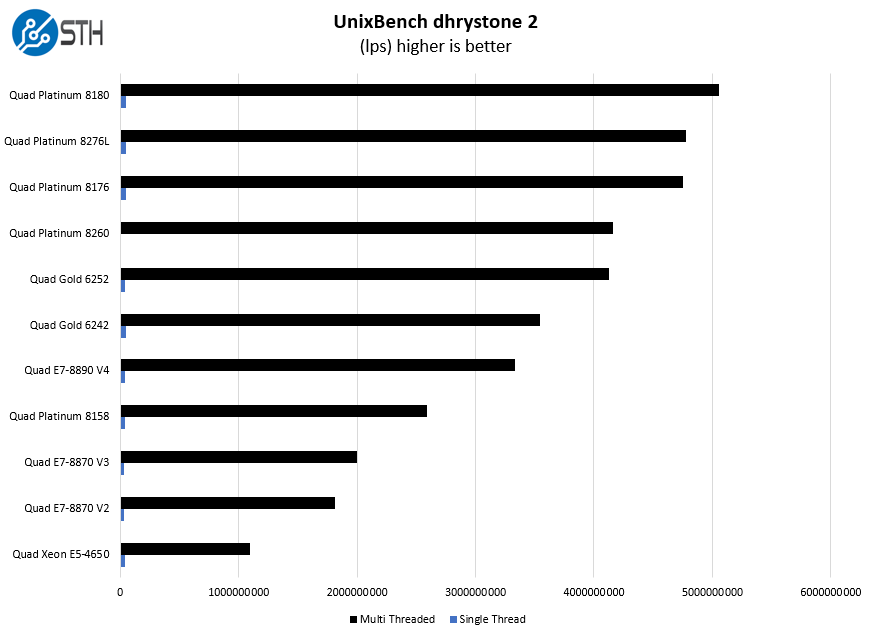
Here are the whetstone results:
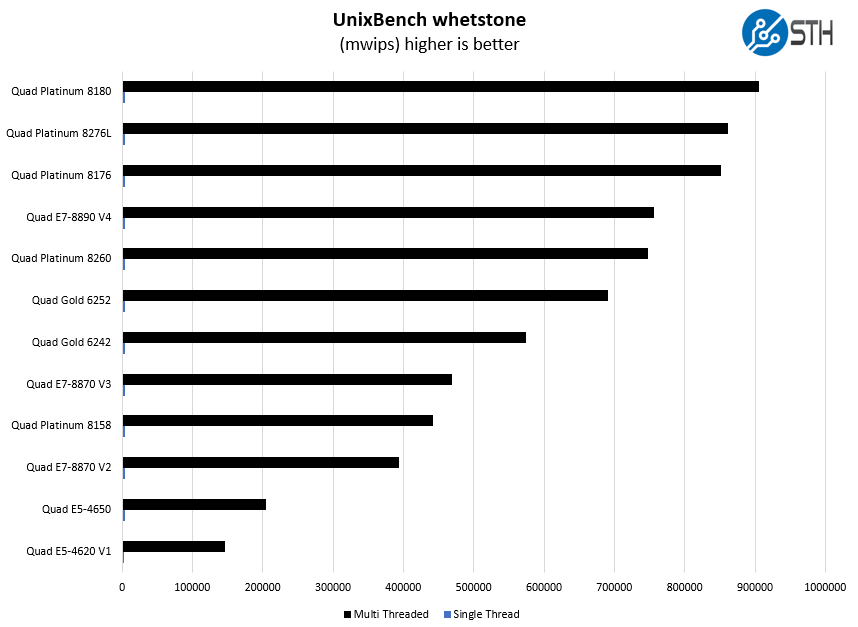
If you have older Intel Xeon E5 or E7 quad configurations, the new chips can provide multiples of performance allowing consolidation ratios greater than 2:1.
Chess Benchmarking
Chess is an interesting use case since it has almost unlimited complexity. Over the years, we have received a number of requests to bring back chess benchmarking. We have been profiling systems and are ready to start sharing results:
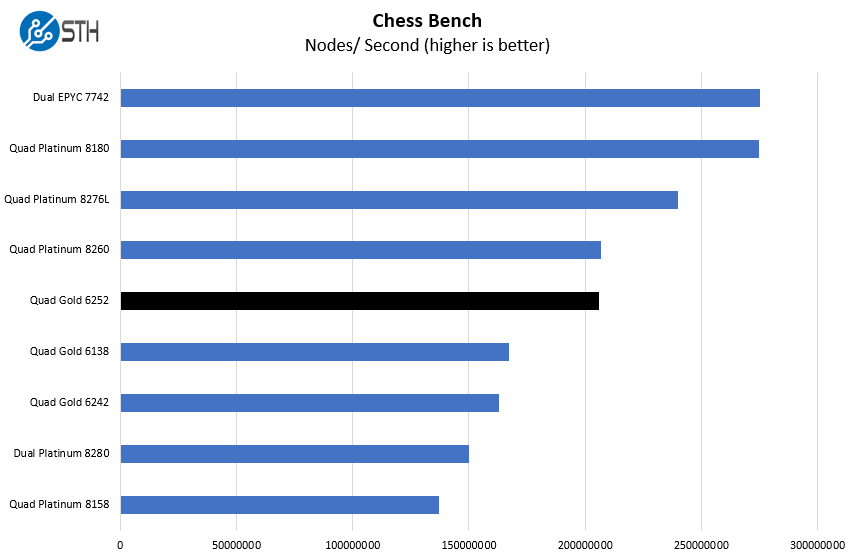
Chess scales well with clock speed and cores. Again we see the dual AMD EPYC 7742 system lead, but the extra TDP of some of the Intel offerings helps here. We also see one of the closest results between the Gold 6252 and Platinum 8260 in this test.
GROMACS STH Small AVX2/ AVX-512 Enabled
We have a small GROMACS molecule simulation we previewed in the first AMD EPYC 7601 Linux benchmarks piece. We are not publishing results of the newer revision here since they are not compatible with our previous results.
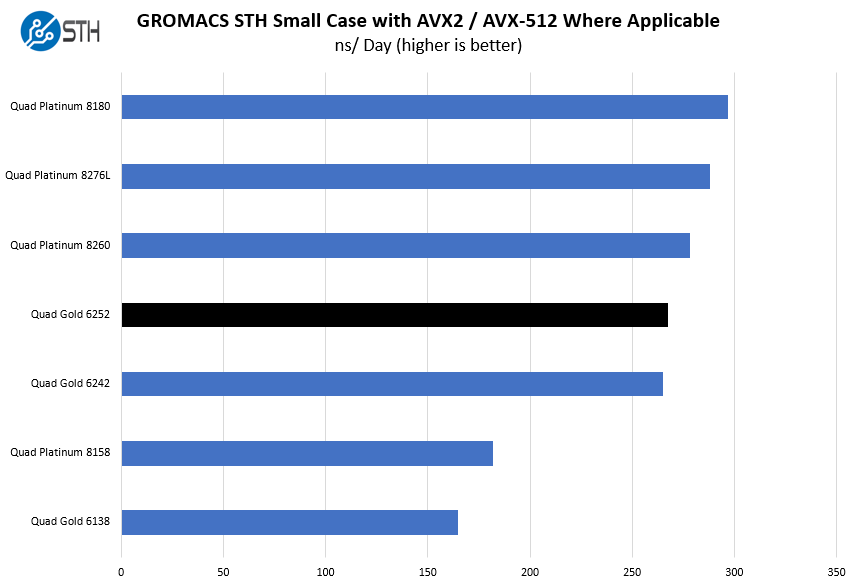
With a 150W TDP, the most interesting result is the comparison to the Gold 6242. The Gold 6252 still has a slight advantage, yet this is not as large as we have seen elsewhere due to the CPUs hitting TDP limits when running AVX-512.
STH STFB KVM Virtualization Testing
One of the other workloads we wanted to share is from one of our DemoEval customers. We have permission to publish the results, but the application itself being tested is closed source. This is a KVM virtualization-based workload where our client is testing how many VMs it can have online at a given time while completing work under the target SLA. Each VM is a self-contained worker.
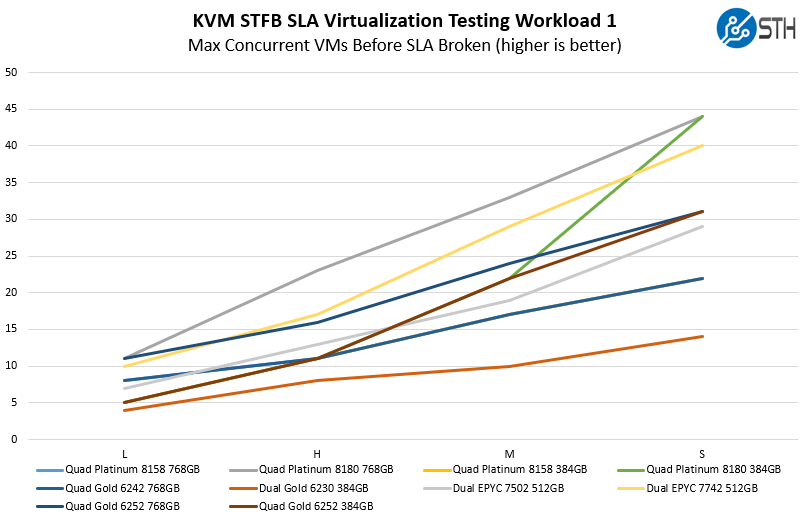
This is a largely CPU bound test, so long as one has enough memory. Here one can see when the 4P Platinum 8180 system is memory constrained, it runs at a rate similar to the 4P Gold 6252 configuration. Once that memory constraint is removed, the Platinum 8180 with 28 cores is considerably faster.
Next, we are going to look at the Xeon Gold 6252 market positioning before moving to our final words.




Any chance we could get some power consumption numbers to go with this? It would be interesting to see a comparison of efficiency on these vs intel’s 205W CPUs.
Do you have any plans to review the 6254 in dual and quad setups in the near future?
Hi thetrashcan – I totally agree. We usually do power on 4P systems in the system itself. In future 4P reviews, perhaps we change the format to include this.
mafigo – I would be OK with STH doing that, but we do not have the parts to do so.